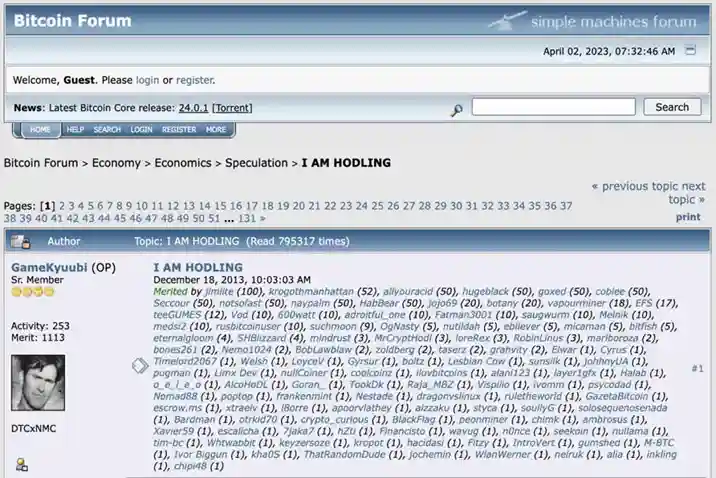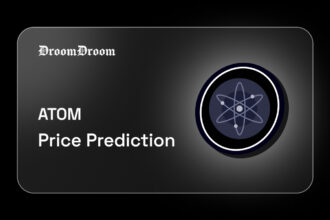It is common for newcomers entering the crypto ecosystem to encounter an extensive list of crypto jargon. From FUD and DYOR to DeFi and DAOs, these terms can represent technical terms that can be confusing for anyone. The crypto ecosystem comprises of digital communities spread across the globe, and crypto-centric terminology is pervasive within these communities. Therefore, it is imperative for any new investor looking to participate in this space to understand crypto concepts to effectively communicate with other participants, whether they be traders, investors, or developers. HODL is another popular crypto-related acronym that has evolved from a buzzword to a full-fledged investment strategy.
The term HODL stands for “Hold Onto Dear Life.” It is a term widely used in crypto forums that represents a long-term investment strategy of buying and holding crypto assets, notwithstanding the notorious volatility of the crypto market.
Understanding the Term “HODL” and Its Origins
The origins of the term HODL can be traced back to the early days of the crypto industry in 2013. Compared to the multitude of altcoins available today, the early cryptocurrency industry only included a small number of crypto assets, including Bitcoin. The term originated in a period in time when Bitcoin was in the middle of a brutal bear market, which had traders on edge. The phrase HODL first appeared on a Bitcoin forum called Bitcoin Talk, where a trader with the username GameKyuubi posted the now infamous typo-filled thread titled “I AM HODLING.”

The intention of the post was to encourage traders to stay the course despite fluctuations in the market. In addition, it was a message to other skeptical traders in the forum to stop trying to time the market or panic sell their positions and instead simply hold their Bitcoin for the long haul. As a result, the term “HODL” originates from the word “hold” being misspelled.
Within a short period, the entire cryptocurrency community identified the misspelled term, HODL, as a long-term investment strategy rather than a simple typo. The acronym “Hold Onto Dear Life” was soon attached to the term as a nod to the volatility of the crypto market. HODL now represents a culture among crypto enthusiasts encouraging other investors to hold or not sell their crypto positions despite market or price fluctuations.
HODLers or those who follow this investment strategy also signal a significant social component. They believe in the long-term price appreciation and promise of cryptocurrency and often HODL to inspire other users on forums and social media platforms to follow suit. Ultimately, HODLing requires a long-term horizon and is the crypto equivalent of the buy-and-hold strategy found in stock markets.
The HODLing strategy is a straightforward investment approach where investors buy cryptocurrencies and store them in their crypto wallets with the hopes of price appreciation over the long term. While HODLing often comes across as a passive investment strategy, returns are not guaranteed, and there are various pros and cons of this strategy that must be acknowledged. Therefore, before deciding to employ a HODL strategy, investors must asses their investment goals and risk tolerance.
Pros of HODLing
Beginner-friendly Strategy
HODL is an investment approach that is in direct contrast to short-term trades employed by day traders. Scalp trading, swing trading, and arbitrage are some methods of trading cryptocurrencies in the short term. To execute a profitable trade, these methods require a high degree of understanding of technical analysis and constant monitoring of price fluctuations in the crypto market.
HODLing, on the other hand, doesn’t rely on timing the market, nor does it necessitate an advanced knowledge of charting tools or indicators. Instead, it is a long-term strategy that simply involves investors buying crypto through an exchange and safely storing their assets in their non-custodial wallets. Therefore, HODLing represents a more hands-off and easy-to-understand approach compared to active trading, making it an attractive strategy for new investors.
Builds discipline
The crypto market’s volatility and common cognitive biases impair investors’ judgment. Read this article to learn about the various psychological traps investors in the crypto space frequently fall into.
By withstanding recessions, bear markets, and short-term price dips, HODLing minimizes emotional decisions by inculcating patience and discipline. Two qualities that are essential for long-term success in the crypto market. Furthermore, by adopting a long-term investment approach, HODLing eliminates the risk of dealing with short-term crypto volatility.
Retweet if you #HODL pic.twitter.com/o63IjBcmaX
— dYdX (@dYdX) March 28, 2023Lower Tax Implications
Selling cryptocurrencies are subject to capital gains tax, and different countries have different crypto tax laws. While crypto taxation is still in its nascency in many countries, many jurisdictions impose higher short-term and lower long-term capital gains rates, just as is the case in traditional financial markets. This means the amount of tax an investor has to pay depends on how long the asset is held before being sold.
By holding crypto assets for longer than a year, investors qualify for lower long-term capital gains taxes. Hence, HODLing can also lessen the amount of tax payable compared to shorter-term trades. That said, it must be noted that countries like India have imposed rigid laws of a flat 30% tax rate with no distinctions between short-term and long-term capital gains. Therefore, it is always essential for investors to understand their countries’ approach to crypto taxation before embarking on any investments.
Cons of HODLing
Uncertainty
The HODL method has been a winning strategy for blue-chip cryptocurrencies like Bitcoin and Ethereum thus far. However, adopting this strategy for other altcoins remains a risky endeavor. Many altcoins do not have sufficient historical data to calculate average yearly returns to gauge future performance and long-term value. Furthermore, numerous altcoins experience drastic price declines and even cease to exist despite solid convictions about their future potential. This was evidenced by the demise of Terra Luna.
Psychological Barriers
The crypto market, like any other financial market, is cyclical, with periods of bullish and bearish price action. However, volatility is turned up a notch in the crypto space. Read this article to learn why this is the case. Therefore, as euphoric as bull markets can be, price drawdowns in the crypto space are just as dramatic. This can be particularly difficult for the faint-hearted. Even the most experienced HODLer may be influenced by the volatility and temporary FUD (Fear, Uncertainty, and Doubt). Therefore, eliminating distractions in the crypto space is easier said than done, especially during bearish phases.
Missed Opportunities
Holding onto crypto assets can result in fruitful returns in the long term. However, it can’t be discounted that trading can result in lucrative returns in a shorter period of time. HODLing limits an investor’s ability to take advantage of short-term market opportunities, such as buying during dips and selling on rallies. Furthermore, committing to a HODL strategy effectively locks up funds that could be deployed to other profitable opportunities.
Considerations When HODLing
HODLing has proven to be an effective investment strategy in the space, especially for established cryptocurrencies like Bitcoin. However, having weighed the pros and cons of this approach, investors must take certain considerations into account.
✨ Exactly 12 years ago, someone bought an Amazon Kindle for 60 #Bitcoin
Cost of the Kindle today: $21
Cost of the BTC today: $1,600,000
HODL 💫 pic.twitter.com/A93bcWpsGx
— RIZZO (@pete_rizzo_) March 28, 2023Firstly, there is no one-size-fits-all approach to HODLing. Some investors create long-term portfolios wherein all crypto assets are held for the long haul. Others choose to HODL certain crypto assets while actively trading other low-cap projects. However, it is always wise to maintain a diversified portfolio. Holding a variety of cryptocurrencies in different sectors minimizes the risk if one segment or asset were to fail.
Secondly, while investing in a lumpsum can yield profitable returns over the long run, there is also the possibility that it could take years to realize profitable returns. This could be especially true when investors purchase their crypto at inopportune times, such as during the peaks of bull markets. Therefore, employing a dollar-cost average (DCA) strategy along with the HODL method is a viable alternative. By purchasing small increments of cryptocurrencies at regular intervals, the DCA approach lessens the impact of crypto volatility while evening out the average price of crypto investments.
Last but not least, since HODLing requires investors to store their assets for years, security becomes imperative. As a result, investors must educate themselves about safety precautions such as counterparty risks of storing assets on centralized exchanges, common scams to look out for, top cryptocurrency wallets such as hardware devices like Ledger or Trezor, and security features like seed phrases.
Conclusion
The term “HODL” supersedes a simple internet meme to represent an established investment strategy among ardent believers of cryptocurrencies’ long-term potential. The wisdom of HODL culture in the crypto space is alive and well. This is evidenced by recent data published by Glassnode, which shows that the number of Bitcoins that have not moved in the past decade exceeds the total supply of Bitcoins on exchanges.
There is now more Bitcoin that hasn't moved in at least 10 years than there is on exchanges. Wild stat.
(h/t @jimmyvs24) pic.twitter.com/8IWMnDO9bk
— Will Clemente (@WClementeIII) February 27, 2023While there are no definitive rules for buying and selling crypto, HODLing represents a relatively straightforward strategy for those looking to bypass the risks of timing the crypto market. That said, rather than adopting complete passivity, those taking proactive steps to learn about the crypto space and monitoring the performance of their portfolios are more likely to succeed.




















